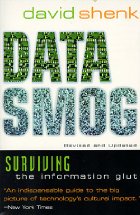 This book is on the recommended reading list for the paper, Information Issues, I am doing through the Open Polytechnic this semester. I wouldn’t normally post about a ‘text book’ on this blog but it is so readable, relevant and thought-provoking that I think it deserves a wider readership.
This book is on the recommended reading list for the paper, Information Issues, I am doing through the Open Polytechnic this semester. I wouldn’t normally post about a ‘text book’ on this blog but it is so readable, relevant and thought-provoking that I think it deserves a wider readership.
David Shenk examines the darker side of the proliferation of information technology that has characterised the last few decades. Information is becoming more plentiful and more easily accessible. According to Shenk “it is estimated that one weekday edition of today’s New York Times contains more information than the average person in 17th century England was likely to come across in an entire liftime.” However, it is possible to have too much of a good thing. An overload of information can lead to a type of Attention Deficit Disorder that is characterised by an inability to focus on one thing for more than a few minutes. Other effects of information overload include: increased cardiovascular stress, weakened vision, confusion, frustration, impaired judgement, decreased benevolence, inability to make reasoned decisions and overconfidence.
Although the amount of information available has increased tremendously, people’s knowledge has not increased. Simply throwing information at people is not enough. Education needs to impart values and critical thinking rather than just information. I (with my librarian’s hat on) believe that librarians have a critical role to play in teaching people how to evaluate the information they find on-line. With so much information available it becomes almost impossible to make considered decisions. This is particularly noticeable in the health field where it seems new studies are continually disproving the findings of previous studies. Red wine is good for you! the headlines trumpet, but a couple of months later, there is a reversal and now it is found to be bad. With so much information, no one can be a Renaissance man (or woman) any more, instead people are experts in very narrow fields and the rest of us need to rely on these experts for advice. If the experts disagree (and they often do) what are we to do?
This trend towards specialisation means that society becomes increasingly fragmented. People tend to move in their own little circles mixing with people very like themselves and when they meet someone from a different sphere – may find that they have very little in common to talk about, very little shared understanding. This rings warning bells for the future of democracy.
People are hardwired to like story as a way of making sense of things and certainly stories are easier to remember than facts and figures. Studies show that if people are given facts or figures that support a particular conclusion and a story that supports the opposite conclusion, they will believe the story rather than the facts. The facts can be repeated over and over again but it is hard to defeat the power of a good story – the kind of story that spreads like wildfire via the Internet as everyone forwards it on to all their contacts without checking its truth.
Shenk believes that journalists are necessary to gather, sift and evaluate information and present us with reasoned, balanced, in-depth stories (I don’t see much of that happening in the Bay of Plenty Times!) and worries that they are being bypassed by the proliferation of newsfeeds, infomercials and advertorials.
This book isn’t all doom and gloom though. Shenk lists a number of ways to reduce the data smog including, turning the TV off, avoiding ‘news-nuggets’, leaving the pager/cell phone behind, limiting e-mail, reducing junk mail/e-mail, resisting advertising, filtering e-mails, not forwarding urban legend e-mails, not adding to the data-smog and taking ‘data fasts’.
Well worth reading.


Leave a comment
Comments feed for this article